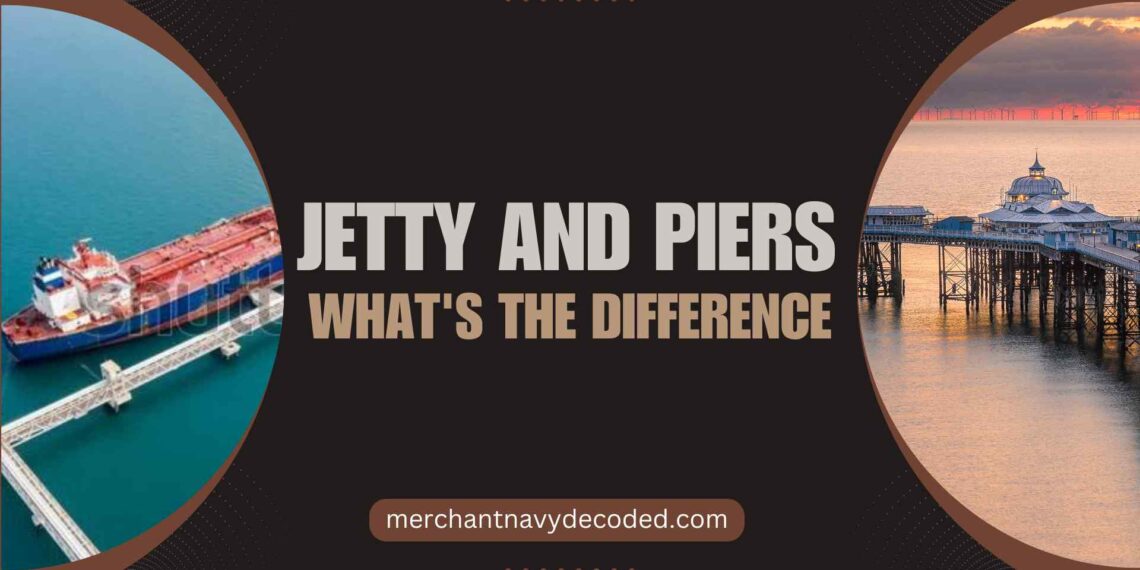Jetty, Piers, and Other Related Structures.
Table of contents
1. Overview:
In the shipping industry, many structures and buildings help in the smoothening of cargo operations and provide a safe place to hold enormous ships during Cargo Operations. We are going to learn about Jetty, Piers, and many other structures without which our shipping industry can’t work at its full potential.
To get more such information regarding the deck side of a ship like ship stability, ship construction, colregs, etc visit our DECK DREAMER package.
2. Jetty:
A long narrow structure that stretches from shore into the water. Structures are generally made up of wood, masonry, concrete, or iron which project at right angles from the coast or some other structure.
- Vessels usually lie alongside the structure.
- The structure that projects from land out in the water
- It may serve as a breakwater and protect the land from currents and tides. In addition to this, the jetty also acts as a walkway.
- Jetties connect the land with the deep waters farther away from shore.
- Jetties are flanked on either side of the river to prevent silting at the mouth.
3. Piers:
The raised structure which rises above the body of water, juts out from its shore. Piers are supported by well-spaced pillars. They are generally made up of wood, masonry concrete, or iron, extending at right angles from the coast into the sea. The open structures( pillars ) allow the tides and currents to flow undisturbed. The size of the pillars may differ from region to region.
3.1. Function of Piers
1:- Handling passengers and cargo is one of the main purposes of the pier.
2:- Piers also provide a fishing place for persons fishing with hooks and fishing lines
3:- Allows the tide and current to flow relatively undisturbed
4. Difference Between Jetty and Piers:
Jetty and Piers are the structures that project out from the land into the water. There is a very small difference between the jetty and piers. The main difference between jetties and piers is that jetty protects the coastline from the tides and currents and on the other hand piers do not disturb the current and tides due to their open structure.
4.1. Some Similar Structures
Mole and Breakwater
A massive structure separating two water bodies, a long pier on the seaward side of the harbor for protection. May be designed for berthing ships on the shoreward side or either alongside or with an anchor.
Docks and Slips
It is necessary to inspect the hull below the water line during a ship’s life periodically to clean the bottom, repair propellers, paint ship sides, etc special docks or slips are built.
Dry Docks and Gravity docks
The excavation lies adjacent to the harbor, river, or basin. The entrance is closed by dock gates.
- Water is allowed until the level in the dock is the same as that outside.
- The entrance is opened and the ship is floated in
- Entrance is closed, and water is pumped out, leaving the ship resting on keel blocks and supported by breast shores from dockside to shipside
Floating Deck
Floating watertight structure, which can be submerged sufficiently to receive a ship by flooding the pontoon tanks
- Pontoon tanks from the bottom of the dock
- After the ship has been floated inside pontoon tanks are pumped out.
5. Frequently Asked Questions:
Q1. What are the different types of docks?
Ans. There are two types of docks dry docks and floating docks.
Q2. What is the purpose of docks?
Ans. Docks serve as the place for repairing and building of the ships. Dry dock hold the ship on the dry platform so that repairing can be done on the hull.
Q3. What is the importance of piers?
Ans. Handling passengers and cargo is the main purpose of the piers.
Q4. What do you understand by the word ‘jetty’?
Ans. A jetty is a structure that juts out from the shore to protect the land from tides and currents.
Q5. Does the jetty float?
Ans. No, a jetty is a fixed structure on the ground, so, it does not float.
Disclaimer :- The opinions expressed in this article belong solely to the author and may not necessarily reflect those of Merchant Navy Decoded. We cannot guarantee the accuracy of the information provided and disclaim any responsibility for it. Data and visuals used are sourced from publicly available information and may not be authenticated by any regulatory body. Reviews and comments appearing on our blogs represent the opinions of individuals and do not necessarily reflect the views of Merchant Navy Decoded. We are not responsible for any loss or damage resulting from reliance on these reviews or comments.
Reproduction, copying, sharing, or use of the article or images in any form is strictly prohibited without prior permission from both the author and Merchant Navy Decoded.



